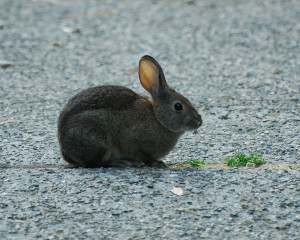As I was getting ready to take the dogs out for their early morning excursion, I looked out the front door, and was met with this view. I immediately muttered “It’s YOU!” and went zipping down the hallway to grab the camera off my desk. Usually this maneuver results in me dashing back for a shot, and finding the bunny has already disappeared, but today the rabbit seemed quite enamored with a small clump of weeds poking through the crack in the driveway. This is the first long look I’ve had at this bunny, as we usually exchange fleeting glances in the garden, and it appears to be one of our native Brush Rabbits (Sylvilagus bachmani), not a rogue escaped pet.
Brush rabbits are crepuscular, most active during twilight at dawn and dusk, and our encounter was quite early this morning. They primarily reside in oak and conifer wooded habitats. Although we’ve removed some sick oaks from the property this year, we still have many more, and conifer-wise we of course have numerous redwood trees, and douglas fir.
Although we were upset to lose our ‘Marvel Stripe’ tomato, even if this bunny was reponsible for the damage, brush rabbits also favor eating many things around here that I’d be happy to have someone help me mow down. They’ll consume thistles and foxtails, which we’ve had in abundance this year, the twigs, bark and leaves of the rambling blackberries on the hillsides, wild rose, clover, and numerous wild grasses.
Brush rabbits, unlike the bunnies I was familiar with as a child in England, do not build vast warrens underground but instead use depressions or hollows in their environment. When scared, they will retreat under low lying brush, rather than running down the ‘rabbit hole’. This particular rabbit, when startled, likes to retreat to the middle of our bank of lavender growing in the front garden.
As adorable as this bunny looks nibbling on the weeds in the driveway, we are approaching the prime breeding season for this species, between December and May. These little rabbits, which range in size from about 10-14 inches long, produce 2-4 litters per year, with an average of 3-4 young per litter. That’s the potential for a lot of new browsing bunnies per year, presuming they all survive of course. Clearly the vegetable garden will need to be secured from a potentially burgeoning bunny population next spring!









